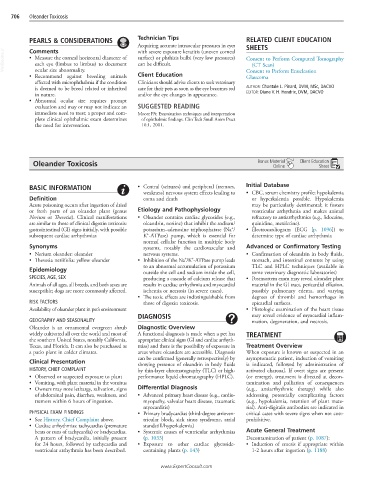Page 1397 - Cote clinical veterinary advisor dogs and cats 4th
P. 1397
706 Oleander Toxicosis
PEARLS & CONSIDERATIONS Technician Tips RELATED CLIENT EDUCATION
Acquiring accurate intraocular pressures in eyes SHEETS
Comments
VetBooks.ir • Measure the corneal horizontal diameter of surface) or phthisis bulbi (very low pressures) Consent to Perform Computed Tomography
with severe exposure keratitis (uneven corneal
can be difficult.
each eye (limbus to limbus) to document
(CT Scan)
ocular size abnormality.
• Recommend against breeding animals Client Education Consent to Perform Enucleation
Glaucoma
affected with microphthalmia if the condition Clinicians should advise clients to seek veterinary
is deemed to be breed related or inherited care for their pets as soon as the eye becomes red AUTHOR: Chantale L. Pinard, DVM, MSc, DACVO
in nature. and/or the eye changes in appearance. EDITOR: Diane V. H. Hendrix, DVM, DACVO
• Abnormal ocular size requires prompt
evaluation and may or may not indicate an SUGGESTED READING
immediate need to treat; a proper and com- Moore PA: Examination techniques and interpretation
plete clinical ophthalmic exam determines of ophthalmic findings. Clin Tech Small Anim Pract
the need for intervention. 16:1, 2001.
Oleander Toxicosis Bonus Material Client Education
Sheet
Online
BASIC INFORMATION • Central (seizures) and peripheral (tremors, Initial Database
weakness) nervous system effects leading to • CBC, serum chemistry profile: hypokalemia
Definition coma and death or hyperkalemia possible. Hypokalemia
Acute poisoning occurs after ingestion of dried may be particularly detrimental; it fosters
or fresh parts of an oleander plant (genus Etiology and Pathophysiology ventricular arrhythmia and makes animal
Nerium or Thevetia). Clinical manifestations • Oleander contains cardiac glycosides (e.g., refractory to antiarrhythmics (e.g., lidocaine,
are similar to those of clinical digoxin toxicosis: oleandrin, neriine) that inhibit the sodium/ quinidine, mexiletine).
+
gastrointestinal (GI) signs initially, with possible potassium–adenosine triphosphatase (Na / • Electrocardiogram (ECG [p. 1096]) to
+
subsequent cardiac arrhythmias K -ATPase) pump, which is essential for determine type of cardiac arrhythmia
normal cellular function in multiple body
Synonyms systems, notably the cardiovascular and Advanced or Confirmatory Testing
• Nerium oleander: oleander nervous systems. • Confirmation of oleandrin in body fluids,
+
+
• Thevetia neriifolia: yellow oleander • Inhibition of the Na /K -ATPase pump leads stomach, and intestinal contents by using
to an abnormal accumulation of potassium TLC and HPLC techniques (available in
Epidemiology outside the cell and sodium inside the cell, some veterinary diagnostic laboratories)
SPECIES, AGE, SEX producing a cascade of calcium release that • Postmortem exam may reveal oleander plant
Animals of all ages, all breeds, and both sexes are results in cardiac arrhythmia and myocardial material in the GI tract, pericardial effusion,
susceptible; dogs are more commonly affected. ischemia or necrosis (in severe cases). possibly pulmonary edema, and varying
• The toxic effects are indistinguishable from degrees of thrombi and hemorrhages in
RISK FACTORS those of digoxin toxicosis. epicardial surfaces.
Availability of oleander plant in pet’s environment • Histologic examination of the heart tissue
DIAGNOSIS may reveal evidence of myocardial inflam-
GEOGRAPHY AND SEASONALITY mation, degeneration, and necrosis.
Oleander is an ornamental evergreen shrub Diagnostic Overview
widely cultivated all over the world and most of A functional diagnosis is made when a pet has TREATMENT
the southern United States, notably California, appropriate clinical signs (GI and cardiac arrhyth-
Texas, and Florida. It can also be purchased as mias) and there is the possibility of exposure in Treatment Overview
a patio plant in colder climates. areas where oleanders are accessible. Diagnosis When exposure is known or suspected in an
can be confirmed (generally retrospectively) by asymptomatic patient, induction of vomiting
Clinical Presentation showing presence of oleandrin in body fluids is indicated, followed by administration of
HISTORY, CHIEF COMPLAINT by thin-layer chromatography (TLC) or high- activated charcoal. If overt signs are present
• Observed or suspected exposure to plant performance liquid chromatography (HPLC). (or emerge), treatment is directed at decon-
• Vomiting, with plant material in the vomitus tamination and palliation of consequences
• Owners may note lethargy, salivation, signs Differential Diagnosis (e.g., antiarrhythmic therapy) while also
of abdominal pain, diarrhea, weakness, and • Advanced primary heart disease (e.g., cardio- addressing potentially complicating factors
tremors within 6 hours of ingestion. myopathy, valvular heart disease, traumatic (e.g., hypokalemia, retention of plant mate-
myocarditis) rial). Anti-digitalis antibodies are indicated in
PHYSICAL EXAM FINDINGS • Primary bradycardias (third-degree atrioven- critical cases with severe signs when not cost-
• See History, Chief Complaint above. tricular block, sick sinus syndrome, atrial prohibitive.
• Cardiac arrhythmias: tachycardias (premature standstill/hyperkalemia)
beats or runs of tachycardia) or bradycardias. • Systemic causes of ventricular arrhythmias Acute General Treatment
A pattern of bradycardia, initially present (p. 1033) Decontamination of patient (p. 1087):
for 24 hours, followed by tachycardia and • Exposure to other cardiac glycoside- • Induction of emesis if appropriate within
ventricular arrhythmia has been described. containing plants (p. 143) 1-2 hours after ingestion (p. 1188)
www.ExpertConsult.com

